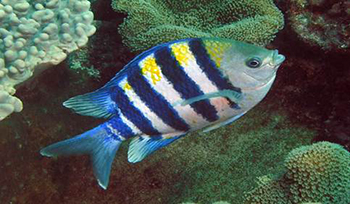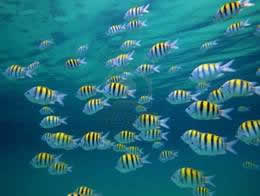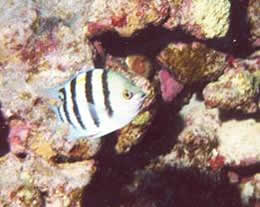Sergeant Major
Abudefdub Saxatilis

Taxonomy
Kingdom Animalia
Phylum Chordata
Class Actinopterygii
Order Perciformes
Family Pomacentridae
General Description
Sergeant Major, also known as the five finger and pilot fish, has stripes that represent the traditional insignia of the military rank. This damselfish is a small, rounded fish that with a body that is compressed laterally, and it has a single nostril on each side of its snout. Changes in color represent a certain stage that the fish is in. While young, it contains a greenish-yellow at the top that shades to white below with five prominent black vertical bars that narrow toward the belly. However, the adult male becomes dark bluish. The maximum length of Sergeant Major is nine inches. They all have two spiny fin rays in the front part of the anal fin and swim mainly by means of the breast fins. Coloration is variable relative to its surroundings. It is in the light phase when over a pale sandy bottom or swimming high above a reef and in the dark phase when down among the crevices in a reef.
Life History/Ecology

(Image: Fishbase.org)
Habitat/location
This reef-associated fish is usually found in tropical areas like Costa Rica and in the Pacific Ocean. Their range also extends to the Atlantic, off the south coast of Central America, United States, and eastern South America. Sergeant Major fish usually inhabit coral reefs at the bottom of the ocean at a depth of one to twelve meters. They are known to form large feeding groups of up to a hundred individuals during certain parts of the year. These schools swim over shallow reef tops during the day and scatter into crevices during the night.
 Resources
Resources
As noted above, the vibrant and colorful Sergeant Major fish like to travel in aggregations while feeding during the day. Their colorful features attract other fish and sea creatures so traveling in schools plays to their advantage. Due to their numerous small teeth, these fish feed on a variety of small food items including algae, small crustaceans, invertebrate larvae, and fish.
 Reproduction
Reproduction
Sergeant Major fish are big time reproducers from November through April and June to August in Jamaica and the Bahamas, respectively. Spawning occurs on rocks, shipwrecks, pilings, and reef outcroppings where the male fish prepares the nest. During the morning hours, males actively chase the females while building their nests. The results show that approximately 200,000 salmon-colored or red oval eggs are released, as shown on the surface in the image to the left. An adhesive filament attaches the egg to the bottom substrate. The eggs hatch approximately 155-160 hours after fertilization.
Behavior
This colorful fish behaves in multiple ways in given conditions but for the most part are curious fish. As mentioned above, Sergeant Major fish take part in “colonial nesting,” during which small groups of these fish merge into larger schools led by dominant males in order to find appropriate nesting sites. When these sites are found, the males break off, clean their sites, and engage in courting rituals to attract the females. The males guard their eggs and offspring actively because they are very protective and possessive about their area and offspring. On the other hand, these large groups that are formed make it hard for predators to focus on one fish, and from far distances, these large groups look like big fish, steering the predators elsewhere.
Research
A recent research study was conducted regarding an eosinophilic granular cell response to a microsporidian infection in a Sergeant Major fish. A microsporidian identified as Glugea was found in the fish. Research showed that xenomas were located in the intestines. Surrounding these xenomas was a layer of eosinophilic granular cells. The researches have not found what this layer entails. However, there is a hypothesis that says that this is a defensive mechanism toward the infiltration and growth of xenomas.
Economic/Ecological Service
The Sergeant Major is not considered endangered according the World Conservation Union (IUCN). It is considered harmless and not a particular food source, although they can be marketed for edible fish. However, they are appreciated in aquariums and displays due to their vibrant colors. There is a healthy abundance of these damselfish and fall prey to typically larger carnivorous fish.
External Links
Please note that the following references may have either been removed or relocated by the webpage owners since the time this student report was created.
http://www.flmnh.ufl.edu/fish/Gallery/Descript/sergeantmajor/sergeantmajor.html good info and pictures
http://sea.sheddaquarium.org/sea/fact_sheets.asp?id=58 good info
Literature Cited
Please note that the following references may have either been removed or relocated by the webpage owners since the time this student report was created.
Annie. “The Sergeant Major Fish.” Costa Rica Scuba. Web. 30 May 2013.
http://www.costarica-scuba.com/sergeant-majors/
Bester, Cathleen. FLMNH Ichthyology Department. Florida Museum of Natural History. Web. 30 May 2013.
http://www.flmnh.ufl.edu/fish/Gallery/Descript/sergeantmajor/sergeantmajor.html
Hvass, Hans. Fishes Of the World. E. P. Dutton and CO., INC. New York (1964) : 37.
Luna, Susan M. “A Linnaeus, 1758.” Fishbase.org. FishBase. Web. 30 May 2013.
http://www.fishbase.org/summary/Abudefduf-saxatilis.html
M. M. Lipsky, et al. "Eosinophilic Granular Cell Response To A Microsporidian Infection In A Sergeant Major Fish, <Em>Abudefduf Saxatilis</Em> (L.)." Journal Of Fish Diseases 10.4 (1987): 319-322. Academic Search Complete. Web. 31 May 2013.
Shedd The World’s Aquarium. Web. 30 May 2013http://sea.sheddaquarium.org/sea/fact_sheets.asp?id=58